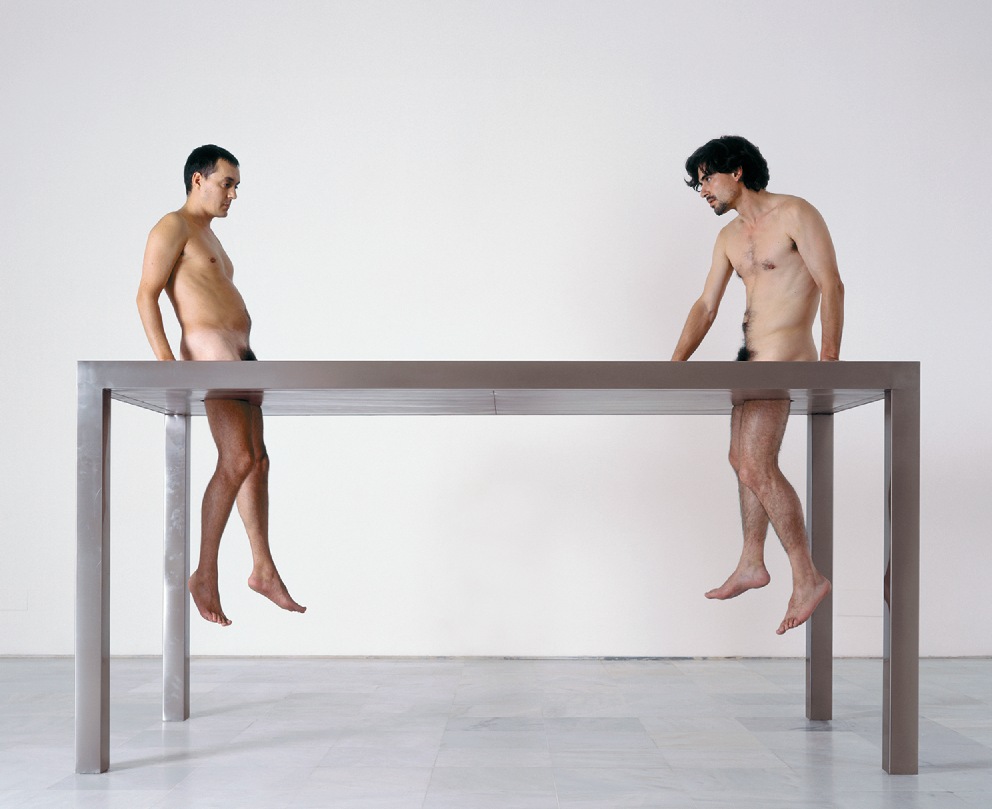

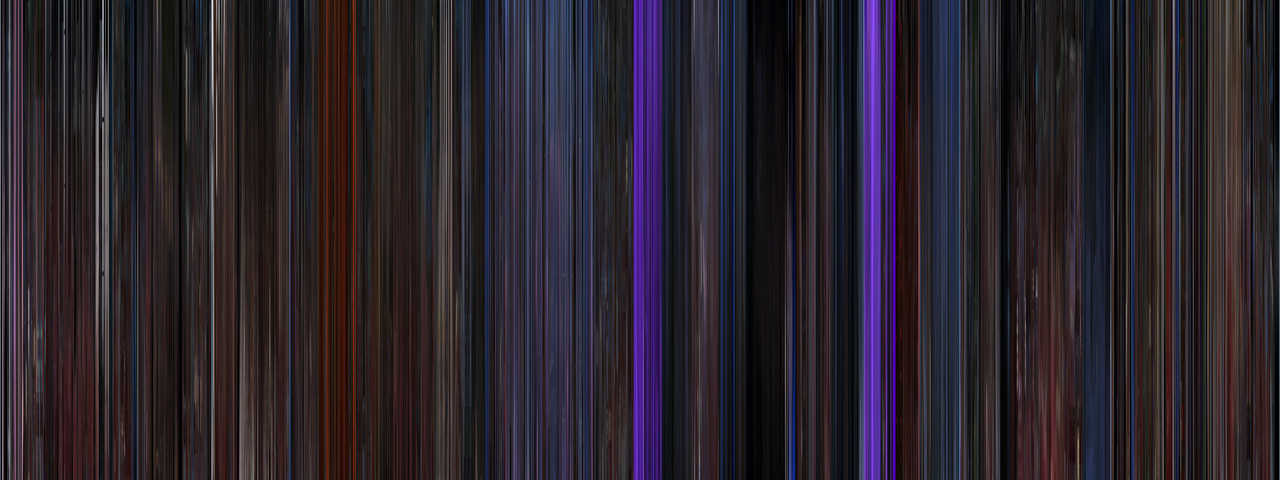
MOVIEBARCODE
STAR TREK VI- THE UNDISCOVERED COUNTRY
Movie Bar Code is based on a simple but amazing concept – take every frame in a movie and compress it into a line. Then put them next to each other and you get a barcode of the movie. Movie Bar Code is brilliant because it gives an interesting perspective into the color palette used by different movies.
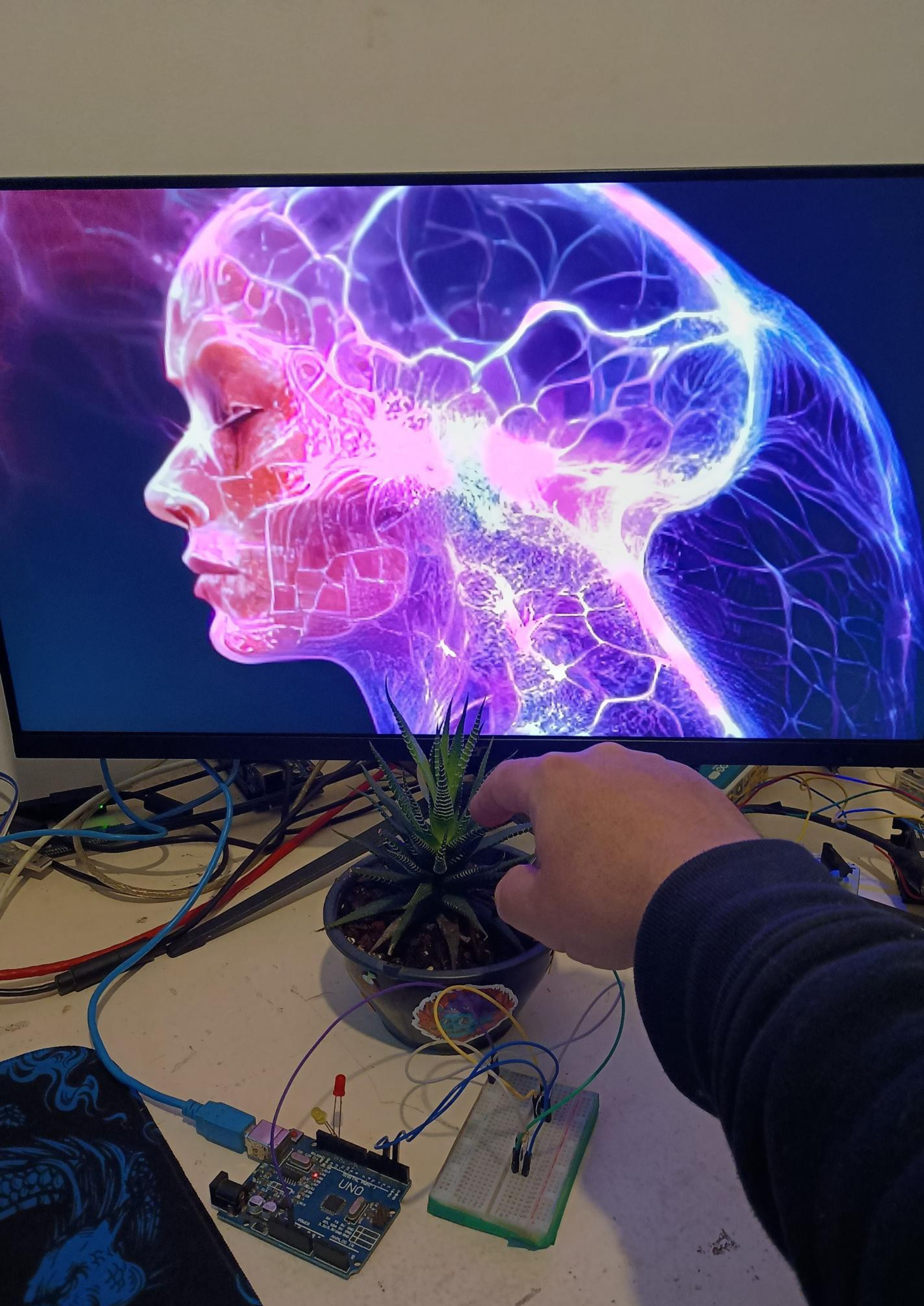
SYNTHETIKA: David Da Paz
Tecnosoma — Circuitos sensíveis na Carne da Máquina
David Da Paz
FILE São Paulo 2025 | Workshop
Festival Internacional de Linguagem Eletrônica
Tecnosoma — Circuitos sensíveis na Carne da Máquina – Brasil
Nesta oficina, os participantes explorarão a fusão entre corpo, tecnologia e inteligência artificial, criando experiências interativas com sensores capacitivos e modelos generativos em tempo real. Inspirada pelo conceito de Tecnosoma — a máquina como organismo sensível e pulsante —, a oficina investiga como o toque humano pode gerar sinais elétricos que ativam respostas audiovisuais, sonoras e lumínicas. Serão abordados microcontroladores (Arduino e ESP32), IA generativa e interatividade sensorial.
BIO
Artista, pesquisador e desenvolvedor, é especialista em IA, machine learning e IoT. Atua há mais de 10 anos com arte interativa, sistemas generativos e instalações sensoriais. Participou da residência Artropocode (Espanha) e da Spontaneous Combustion Residency (Londres), explorando performances ciberurbanas e mídias locativas.
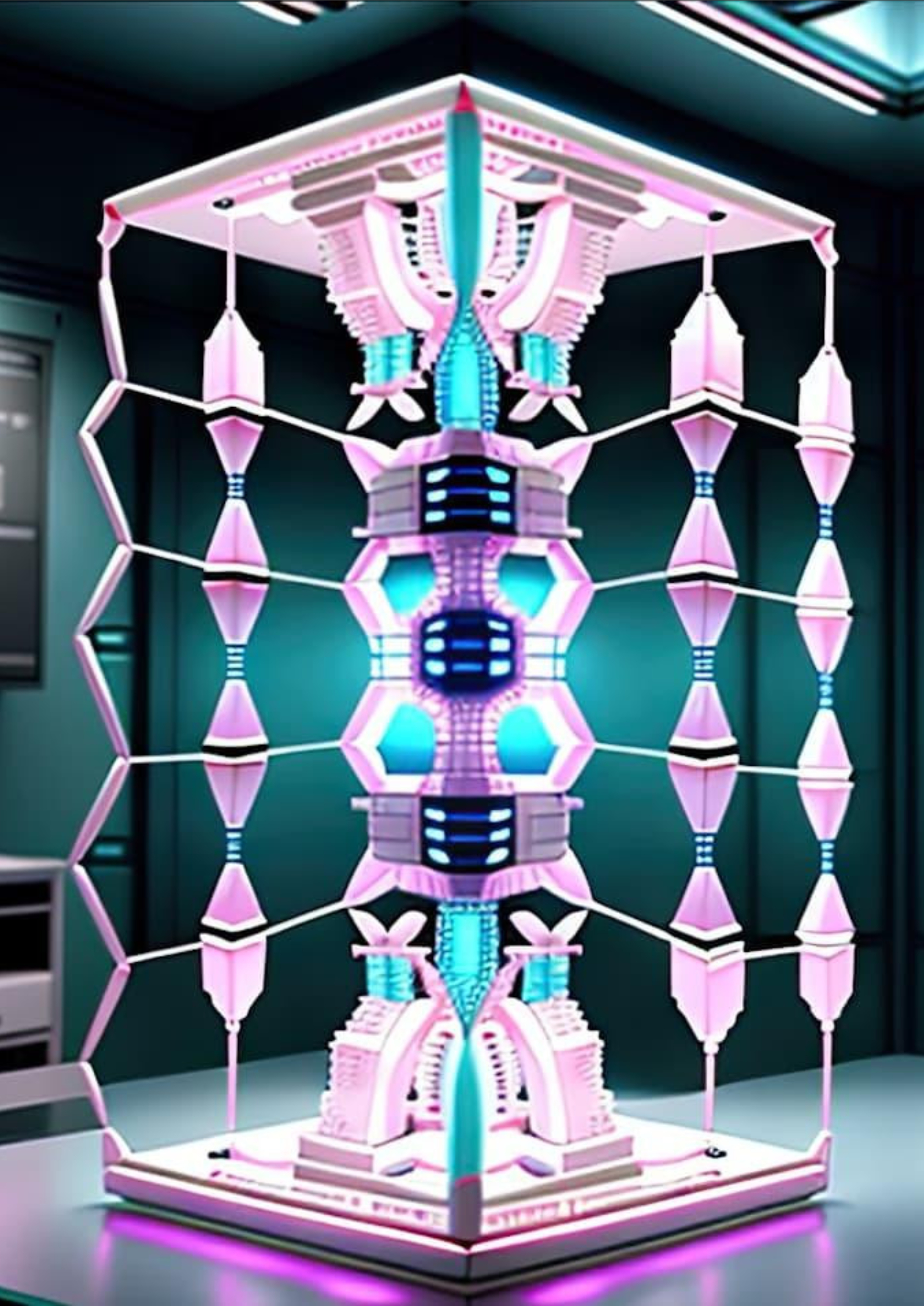
SYNTHETIKA: Callahan Indovina
Daily Diffusion 53 & 86
Callahan Indovina
FILE São Paulo 2025 | AI Videos
Festival Internacional de Linguagem Eletrônica
Daily Diffusion 53 & 86 – Estados Unidos
A série Daily Diffusion de Callahan Indovina foi um projeto de três meses lançado em 2024, quando as ferramentas de IA generativa e diversas plataformas para automatizar animações e fluxos de trabalho ainda estavam em estágio emergente. A série no YouTube tinha como objetivo fornecer fluxos de trabalho, prompts e exemplos sobre como utilizar o Stable Diffusion e vários processos de melhoramento de dados para criar animações psicodélicas. Como muitas de suas obras, a série Daily Diffusion se inspirou nas experiências de Callahan dentro de seus sonhos.
Música: https://www.mubert.com
BIO
Callahan Indovina é um artista espiritualista e psicodélico da Sierra Nevada, Califórnia. Sua expressão artística combina técnicas tradicionais de composição digital com práticas inovadoras, como o uso de IA generativa. Suas criações, descritas como sobrenaturais e oníricas, refletem sua visão surreal e transcendental, extraída de experiências vividas em seus sonhos.

QUBIT AI: Luigi Novellino (aka PintoCreation)
Blob Alien Mouth
FILE 2024 | Interator – Sound Synthetics
International Electronic Language Festival
Luigi Novellino (aka PintoCreation) – Blob Alien Mouth – Italy
The journey begins with Deforum, using the Automatic1111 interface to create basic images with the StableDiffusion XL, EndjourneyXL, and Lora XLFullArt templates. The video undergoes a transformation using the Absolute Reality model and Lora Aurora style, guided by the IPAdapter node and refined by QrCode Controlnet.
Bio
Fascinated by the limitless domain of AI, Luigi Novellino adopts the title syntographer, a term that resonates deeply within the community. The artist often asks himself: “am I an artist?” Art, in his view, defies rigid definitions or limits; it represents a fluid expression of creativity that transcends labels. The artist’s ultimate goal is to awaken something in the viewer, provoking thoughts and evoking emotions.
Credits
Music: Oleh Boretskyi

QUBIT AI: Eduardo Reck Miranda
Sounding Qubits
FILE 2024 | Quantico
International Electronic Language Festival
Eduardo Reck Miranda – Sounding Qubits – Brazil
Although he has learned classical musical instruments since childhood, Eduardo Miranda’s favorite tool for composing is the computer. The researcher has been delving into artificial intelligence and innovative computing methods for compositing for some time, as they offer fresh insights and ideas beyond his own.
A quantum computer deals with information encoded as qubits. A qubit is to a quantum computer what a bit is to a digital one: a basic unit of information. In hardware, qubits exist in the subatomic world. They are subject to the laws of quantum mechanics.
Quantum computers are like super-powered versions of classical digital computers. While a digital computer processes data in a linear, step-by-step fashion, a quantum computer can explore many possibilities at once.
Operating a quantum computer requires different ways of thinking about encoding and processing information. This is where composers can benefit greatly. This technology is destined to facilitate the development of unprecedented ways of creating music.
Bio
Composer who works at the intersection of music, science and new technologies. His background as an artificial intelligence scientist and classical composer with early involvement in avant-garde pop music informs his distinctive music. He has composed for BBC Radio 3, BBC Concert Orchestra, BBC Singers and Scottish Chamber Orchestra. He is a professor at the University of Plymouth and a research associate at Quantinuum, where he explores music composition with quantum computers.

Leo Villareal
Bloom Nebula
Incorporating LEDs, electronics, and custom code, this sequenced light sculpture exemplifies Villareal’s latest inquiries into natural and synthetic systems.

VÉRONIQUE BÉLAND
As We Are Blind
As We Are Blind calcule et interprète en temps réel ces données physiologiques sous la forme d’une production musicale et photographique unique. Le spectateur pose la main sur un capteur mesurant son activité électrodermale, une action permettant de dresser sa cartographie émotionnelle. Les valeurs recueillies, qui représentent des variations propres à chaque individu, sont d’abord converties sous la forme d’une image révélant son champ électromagnétique. Puis, ces données physiologiques sont analysées par un programme informatique capable, en suivant des règles de composition préétablies, de les transcoder en partition musicale.

Universal Everything
Primordial
Primordial is a generative artwork made from code, depicting a stylised, coloured take on cellular microscopic life. The flow of organisms projected onto the floor are audio responsive, moving and growing to the pulse of sound. These creatures navigate the space in their own freeform way, naturally encouraging viewers to flow into the exhibition.

Bernd Lintermann and Peter Weibel
YOUR:R:CODE
Il titolo può essere letto in due modi diversi: l’interpretazione »your code« indica che nell’installazione i visitatori sperimentano diversi tipi di trasformazioni digitali di se stessi. Mentre entrando, un visitatore vede ancora il suo riflesso familiare in uno specchio – la rappresentazione virtuale più reale che possiamo immaginare – l’immagine speculare si trasforma gradualmente in un corpo di dati digitale finché, infine, il visitatore è ridotto a un codice leggibile industrialmente. Alla fine si libera dalla rappresentazione virtuale e si materializza in un display flip-dot. Il secondo modo di leggere il titolo del pezzo, »tu sei codice«, sottolinea che noi stessi siamo costituiti da codice, che tra l’altro si manifesta nel codice genetico.

Cao Yuxi
Shenzhen Citizen Square
Cao Yuxi is een nieuwe mediakunstenaar wiens oeuvre zich uitstrekt over audiovisuele installaties, interactieve kunst, meeslepend ruimtelijk ontwerp en codering. Van zijn monumentale show in Shenzhen, waar 41 gebouwen van de skyline van de stad als canvas werden gebruikt, tot de hypnotiserende audiovisuele serie Dimensional Sampling en de op QR-codes geïnspireerde beelden, Cao’s werk confronteert de menselijke waarneming en daagt de kijker uit om na te denken over de veelzijdige aspecten van het moderne leven en het digitale tijdperk.

Engineered Arts
AMECA
“Multiply the power of artificial Intelligence with an artificial body. Ameca is the physical presence that brings your code to life. The most advanced lifelike humanoid you can use to develop and show off your greatest machine learning interactions. This robot is the digital interface to the real world.” Engineered Arts
.
“A U.K. robotics firm called Engineered Arts just debuted the first videos of its new humanoid robot, which is able to make hyper-realistic facial expressions. It’s a pretty stunning achievement in the world of robotics; it just also happens to be absolutely terrifying.
Named Ameca, the robot’s face features eyes, cheeks, a mouth, and forehead that contort and change shape to show off emotions ranging from awe to surprise to happiness. One of the new videos of Ameca shows it waking up and seemingly coming to grips with its own existence for the first time ever.” Neel V.Patel

UVA UNITED VISUAL ARTISTS
Entwurf
Blueprint umfasst die Beziehung und Parallelen zwischen Kunst und Wissenschaft und schafft Kompositionen durch die mathematischen Prinzipien der Logik, die das Leben stützen. UVA untersucht Analogien zwischen DNA und Computercode und hat die Blueprint-Serie entwickelt. Arbeiten, die Genetik und Code als Blaupausen künstlicher und natürlicher Systeme verbinden. Da sich die Arbeit im Laufe der Zeit langsam ändert, schwanken die Muster zwischen verschiedenen Komplexitätsgraden. Blueprint verwendet die Grundkonzepte der Evolution, um ein sich ständig veränderndes Bild zu erstellen. Während Zellen ihre Gene buchstäblich auf ihre angrenzenden anderen übertragen, fließt Farbe wie Farbe über die Leinwand. Blueprint erstellt jede Minute eine einzigartige farbenfrohe Komposition und präsentiert das unbegrenzte Ergebnis, das sich aus einem einzigen Algorithmus ergibt. ein einziges Regelwerk.

DNA REAL-TIME SPEED
DNA (genes)
A gene is a sequence of DNA that contains genetic information and can influence the phenotype of an organism. Within a gene, the sequence of bases along a DNA strand defines a messenger RNA sequence, which then defines one or more protein sequences. The relationship between the nucleotide sequences of genes and the amino-acid sequences of proteins is determined by the rules of translation, known collectively as the genetic code. The genetic code consists of three-letter ‘words’ called codons formed from a sequence of three nucleotides.

LEO VILLAREAL
CYLINDRE
Dans cette installation étincelante intitulée Volume, l’artiste Leo Villareal a pris une poignée d’étoiles scintillantes et les a ramenées sur terre. La partie cylindrique était suspendue au plafond et contenait plus de 20 000 lampes LED en acier inoxydable réfléchissant et hautement poli, qui créaient un espace tridimensionnel dans lequel la lumière pouvait prendre vie. Les modèles d’éclairage, contrôlés par la conception du code logiciel de Villareal, se déplacent à différentes vitesses, cycles d’allumage et d’extinction et vagues de luminosité et d’obscurité. Selon un critique, « la pièce est un poème d’argile éblouissant qui attire le spectateur dans un espace abstrait profond tout en déformant la perception temporelle et visuelle. » Villareal n’est pas un débutant en matière de sculptures lumineuses étonnantes. Découvrez ce tunnel de spectacle de lumière de 200 pieds qu’il a installé sur l’allée du hall des bâtiments est et ouest de la National Gallery of Art. L’espace entre les installations de Villareal et son public est un facteur important car les spectateurs sont entrelacés avec les lumières qui pulsent tout autour.

Tacit Group
61/6 haut-parleurs
Tacit Group est un groupe de performance audiovisuelle qui a été formé en 2008 pour créer une œuvre axée sur l’algorithmique et l’audiovisuel. Son art algorithmique se concentre sur le processus plutôt que sur le résultat. Ils créent du code mathématique, des systèmes utilisant des principes et des règles, et improvisent des performances scéniques à l’aide des systèmes. Pendant la représentation, les systèmes sont révélés visuellement et sonorement, afin que le public puisse entendre avec leurs yeux, comme on voit “Le Cri” d’Edvard Munch (Norvège, 1863-1944). Les images font partie intégrante du travail du Groupe Tacit en tant que compositeurs et artistes médiatiques. Ils espèrent qu’en montrant non seulement la pièce finie, mais le processus de discussion ou de jeu qui la génère, ils engageront plus intensément leurs téléspectateurs et briseront la division conventionnelle entre les interprètes et les membres du public. Aucun de ses travaux n’est jamais terminé. Ils mettent continuellement à jour les systèmes sous-jacents et s’inspirent de leur pratique de la programmation informatique. En tant qu’artistes de notre époque, Tacit Group découvre les possibilités artistiques de la technologie.

Claire Malrieux
Climat General College des Bernardins
Se référant à l’« Hypothèse Gaïa » de James Lovelock, Malrieux transforme la figure de Gaïa en une machine climatique autonome qui affiche un espace dynamique et organique, construit selon des flux de données empruntés aux principaux modèles climatiques prédictifs. A travers différents scénarios programmatiques, l’artiste met en évidence l’influence de l’homme sur son environnement, un environnement en perpétuelle mutation dont la fin ne peut être programmée. Car si l’entrée dans l’anthropocène marque la fin d’une Terre en extension, elle marque surtout le début d’autre chose : une situation différente dans le temps et dans l’espace. Un espace où le décor est en mouvance et dans lequel l’histoire humaine s’adapte et évolue.
L’usage simultané du dessin et des algorithmes permet de visualiser des interactions et des causes à effets habituellement invisibles, de les décoder et d’en interroger les enjeux.
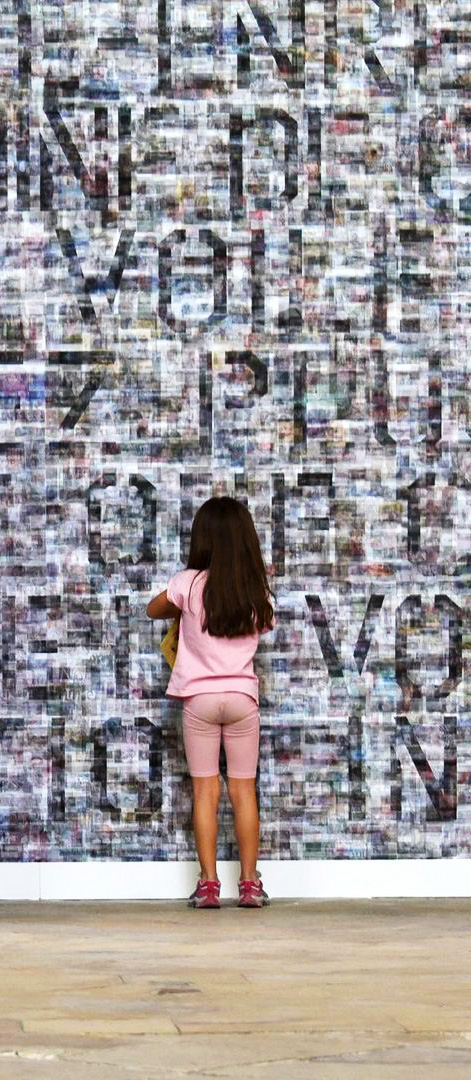
Pascal Dombis
La Génération Invisible
La Génération Invisible est une installation dans laquelle Pascal Dombis questionne notre rapport aux images numériques et comment nous les regardons aujourd’hui. Internet génère une profusion d’images qui circulent et qui sont de moins en moins regardées par les humains. Cette installation parle de la disparition des images de par leur circulation et prolifération excessive. Le mur est couvert par un flux de 30 000 images internet entrelacées formant une surface visuelle floue. La nature individuelle de chacune des images peut être décodée par l’utilisation d’une plaque lenticulaire que le visiteur applique directement contre le mur, afin d’en extraire de multiples lectures. Cette installation fait écho au travail de William Burroughs sur le langage et les images en reprenant une phrase d’un de ses livres Cut-Up de 1961 :

BERND LINTERMANN AND PETER WEIBEL
YOUR:R:CODE
LE TITRE PEUT ÊTRE LIRE DE DEUX MANIÈRES DIFFÉRENTES : L’INTERPRÉTATION “VOTRE CODE” INDIQUE QUE PENDANT L’INSTALLATION, LES VISITEURS OBSERVENT DIFFÉRENTS TYPES DE TRANSFORMATIONS NUMÉRIQUES D’EUX-MÊMES. EN ENTRANT, UN VISITEUR VOIT TOUJOURS SON REFLET DE FAMILLE DANS UN MIROIR – LA REPRÉSENTATION VIRTUELLE LA PLUS RÉELLE QUE NOUS POUVONS IMAGINER – L’IMAGE DU MIROIR SE TRANSFORME PROGRESSIVEMENT EN UN CORPS INDUSTRIEL DE DONNÉES NUMÉRIQUES JUSQU’À CE QU’UN VISIBLE CODÉ À LECTURE, ENFIN, LE REPRESENTATIF. AU FINAL, IL EST EXEMPT DE REPRÉSENTATION VIRTUELLE ET SE MATÉRIALISE DANS UN ÉCRAN FLIP-DOT. LA DEUXIÈME FAÇON DE LIRE LE TITRE DE LA PIÈCE, « VOUS ÊTES CODE », SOULIGNE QUE NOUS SOMMES NOUS-MÊMES CONSTITUÉS D’UN CODE, QUI, ENTRE AUTRES, EST MANIFESTÉ DANS LE CODE GÉNÉTIQUE.
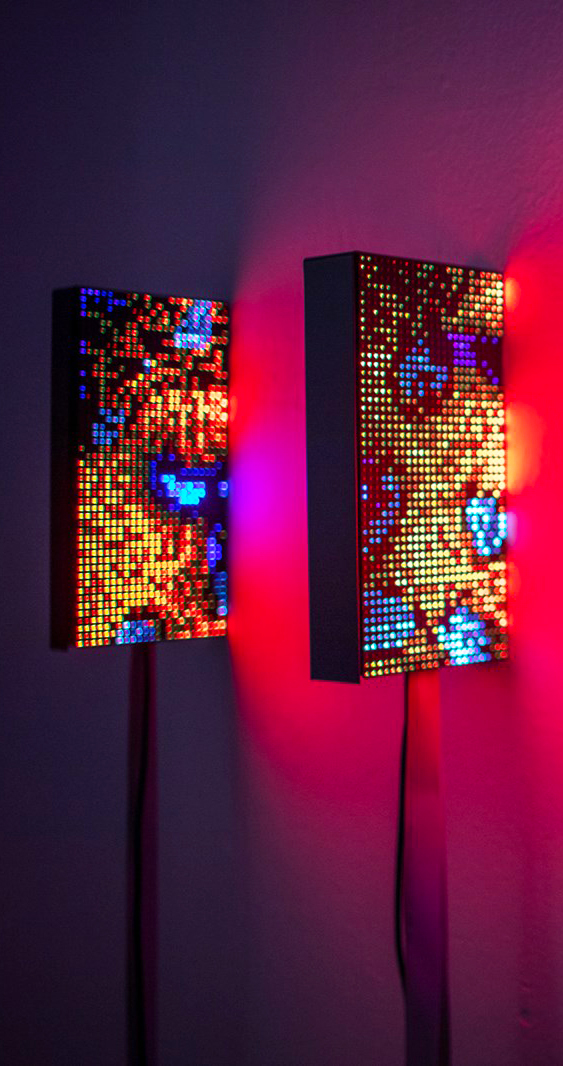
Daniel Canogar
Fulgurations
Fulgurations is een generatieve installatie samengesteld uit een reeks LED-schermen die een inhoud in constante mutatie toont. Het reageert op een algoritme ontworpen door Studio Daniel Canogar, geïnspireerd door de cellulaire activiteit en ander soort collectief gedrag en natuurpatronen. De code die deze beelden regeert, maakt gebruik van het computationele principe van cellulaire automaten, ontwikkeld door de wiskundige John von Neumann. De logica van dit systeem werkt door de invloed van naburige eenheden, wat collectief gedrag in de keten uitlokt met een hoge esthetische waarde.

MARCIUS GALAN
diagonal section
With a recognisably minimal aesthetic, Galan employs abstract geometry to delineate the political and social implications of his chosen environments, deconstructing the codes of objects established through everyday use.

Driessens & Verstappen
Breed
Breed (1995-2007) is a computer program that uses artificial evolution to grow very detailed sculptures. The purpose of each growth is to generate by cell division from a single cell a detailed form that can be materialised. On the basis of selection and mutation a code is gradually developed that best fulfils this “fitness” criterion and thus yields a workable form. The designs were initially made in plywood. Currently the objects can be made in nylon and in stainless steel by using 3D printing techniques. This automates the whole process from design to execution: the industrial production of unique artefacts.
Computers are powerful machines to harness artificial evolution to create visual images. To achieve this we need to design genetic algorithms and evolutionary programs. Evolutionary programs allow artefacts to be “bred”, rather than designing them by hand. Through a process of mutation and selection, each new generation is increasingly well adapted to the desired “fitness” criteria. Breed is an example of such software that uses Artificial Evolution to generate detailed sculptures. The algorithm that we designed is based on two different processes: cell-division and genetic evolution.

OLAFUR ELIASSON
Algenfenster
Algenfenster ist eine Anordnung von Glaskugeln, die in einer Wand montiert sind. Direkt hinter der Wand und den Kugeln befindet sich ein Fenster; So erscheinen in jeder Sphäre lebendige, invertierte Miniaturansichten der Szene außerhalb der Galerie und bewohnen sie. Die Zusammensetzung der Arbeit ähnelt stark der Struktur eines Typs einzelliger Algen, die als Kieselalgen bekannt sind und große Mengen Kohlenstoff aus der Atmosphäre entfernen.
.
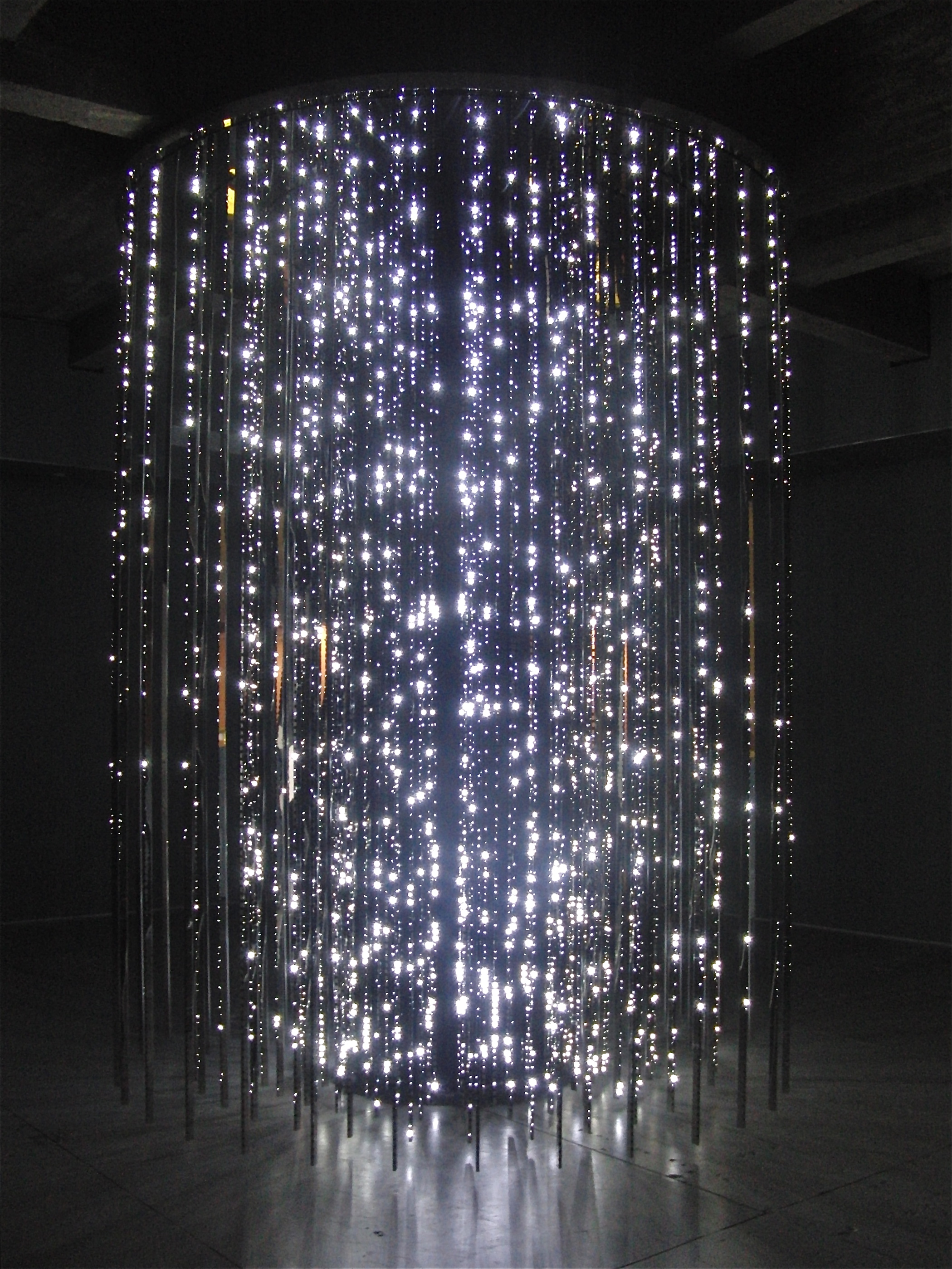
LEO VILLAREAL
레오 비야 레알
ЛЕВ ВИЛЬЯРРЕАЛ
Zylinder
In dieser funkelnden Installation mit dem Titel Volume nahm der Künstler Leo Villareal eine Handvoll funkelnder Sterne und brachte sie auf die Erde. Das zylinderförmige Teil hing an der Decke und enthielt mehr als 20.000 LED-Leuchten aus reflektierendem, hochglanzpoliertem Edelstahl, die einen dreidimensionalen Raum schufen, in dem Licht lebendig werden konnte. Die Beleuchtungsmuster, gesteuert durch Villareals Software-Code-Design, Bewegen Sie sich in verschiedenen Geschwindigkeiten, Ein- und Ausschaltzyklen und Wellen von Helligkeit und Dunkelheit. Einem Rezensenten zufolge ist „das Stück ein schillerndes Tongedicht, das den Betrachter in einen tiefen, abstrakten Raum zieht, während es die zeitliche und visuelle Wahrnehmung verzerrt.“ Villareal ist kein Anfänger, wenn es um erstaunliche Lichtskulpturen geht. Schauen Sie sich diesen 200 Fuß langen Lichtshow-Tunnel an, den er auf dem Concourse-Gehweg der Ost- und Westgebäude in der National Gallery of Art installiert hat. Der Raum zwischen Villareals Installationen und seinem Publikum ist ein wichtiger Faktor, da die Zuschauer mit den Lichtern verflochten sind, die ringsum pulsieren.

Jim Chen-Hsiang Hu

FIELD
Esthétique du système
Les travaux de cette série font partie d’un vaste projet de recherche de FIELD, explorant les algorithmes d’apprentissage automatique les plus pertinents dans des illustrations à base de code […] Nous avons commencé une exploration plus approfondie des informations moins accessibles qui existent, telles que les articles scientifiques et des publications de code open source, pour développer une compréhension du fonctionnement interne de ces algorithmes, et le traduire en métaphores visuelles qui peuvent contribuer à un débat public.

LEO VILLAREAL
Sterndecke
Star Ceiling drückt die lebendige Dynamik der Natur aus – von wogenden kosmischen Wolken und schwärmenden Massen bis hin zu radialen Ausbrüchen, spiralförmigen Wirbeln und turbulenten Wellen – und untersucht die Spannung zwischen rationaler und transzendenter, zwischen menschlicher und nicht menschlicher Welt. Villareals Kunstwerk belebt leblose Materie durch das unsichtbare Medium Code und führt zu einer tiefen Verbundenheit und einem seltenen Erfahrungsbewusstsein.

CAO YUXI
Dimensionale Abtastung
Dimensionale Abtastung ist ein digitales Projekt für zeitgenössische Kunst, das 2019 von Cao Yuxi Studio gestartet wurde. Das Kernkonzept des Projekts basiert auf dem digitalen Totem des Totems der Ära, das durch den QR-Code-Bildstil dargestellt wird, und untersucht das digitale weiter Zeitalter der neuen Ära. Diese Installation der AudioVisual-Version ist ein Gemeinschaftsprojekt, das mit dem in Hongkong ansässigen Klangkünstler Lawrence Lau erstellt wurde.

Kengo Kuma
Botanical Pavilion
To realize the ‘Botanical Pavilion’, Kengo Kuma worked alongside Geoff Nees — a melbourne-based artist and curator who has also worked on a number of architectural pavilions. Made in the japanese tradition of wooden architecture, where pieces interlock, held by tension and gravity, the structure at the NGV triennial features a tessellated interior lined with timber collected from trees felled or removed over several years at Melbourne’s royal botanic gardens. Some of the trees used within the architecture pre-date european settlement, while others signal the development of the gardens as a site of scientific research and botanical classification. Prioritizing natural phenomena over scientific order, the botanical species used are color-coded, rather than following any taxonomic order. this approach offers a statement by the designers against the reductive nature of science during the colonial era — a mindset at odds with many indigenous cultural beliefs and knowledge systems.

Studio TheGreenEyl
Appeel
»Appeel« is a game without rules. It starts with a wall that is covered all over with a signal red adhesive foil. The foil consists of thousands of circular stickers pre-cut in a narrow grid that wait to be pulled off and put in a new order by the visitors. The stickers, and its white negative on the wall, form, similarly to binary coded pixels, ornaments, news and pictures – on the original wall and far beyond: they move to adjoining rooms, onto faces and even leave the city.

FARBRAUSCH
rove (Demoscene)
Farbrausch, also farb-rausch, is a German demo group that has been very well known in the Demoscene since the release of their intro fr-08: .the .product in December 2000. Their demo fr-025: the.popular.demo, which was published at Breakpoint 2003, has gained notoriety far beyond the borders of the scene, both The.Popular.Demo and debris. are two of the most popular demos according to the comparative index Pouët. The works of farbrausch have won numerous prizes in the Demoscene: The.Popular.Demo won the “Public Choice Award” of the Scene.org awards in 2003 Scene.org awards of 2003, category “Public Choice Award”., .Debris 2007 the award for best director. Scene.org awards of the year 2007, category Director.Farbrausch gives all publications a “product code” in the format “fr-0 #”. The numbers are not related to the date of publication, but rather, according to the members of farbrausch, indicate the order in which work on the project began. Productions that are not meant to be taken seriously are also given a “minus” in their name. 2004 the sub-department of farbrausch .theprodukkt released a 96kB small first-person shooter called .kkrieger, as well as the early version of a tool for creating demos called.

UVA UNITED VISUAL ARTISTS
Blueprint
Blueprint embraces the relationship and parallels between art and science, creating compositions through the mathematical principles of logic that underpin life. Exploring analogies between DNA and computer code, UVA have created the Blueprint series; works that pair genetics and code as the blueprints of artificial and natural systems. As the work slowly changes over time, patterns fluctuate between varying degrees of complexity. Blueprint uses the basic concepts of evolution to create an ever-transitioning image. With cells literally transferring their genes to their adjoining others, colour flows like paint across the canvas. Drawing up a unique colourful composition every minute, Blueprint presents the unlimited outcome that results from a single algorithm; a single set of rules.

Ani Liu
Untitled: (A Search for Ghosts in the Meat Machine)
What does it mean to be human? At first glance a simple question, the idea of being human is an unstable construct, continuously recrafted. Recent technological innovations allow us to redesign ourselves profoundly— from networked prosthetics and artificial intelligence, to the genetic code of life itself. Can our behaviors be reduced to algorithms? Can our bodies be upgraded with nonorganic integrations? Can sentience itself by manufactured in a lab? This set of nine sculptures examines personhood from anatomical, psychological, genetic, biochemical, behavioral, algorithmic, personal narrative and memory. In many ways, this installation is an emotional confrontation with being quantifiable.

Trisha Brown
Newark & M.G
La place de Trisha Brown dans l’histoire de la création Outre-Atlantique est unique : après Martha Graham et sa modern dance, Merce Cunningham qui dynamite les codes, Trisha Brown va s’imposer dans un courant, la danse postmodern qui a influencé nombre de chorégraphes actuels. La danse ici est jaillissante, faite de duos de plus en plus complexes avec bien sûr ce jeu des équilibres instables comme autant de coups d’arrêt au geste. Le plus souvent, sous nos yeux, un couple d’interprètes voit surgir un autre tandem dans un incessant jeu de déconstruction des lignes. Des marches, des courses, des dialogues féconds s’instaurent en scène. Newark est pour beaucoup une des grandes pièces de Trisha Brown.
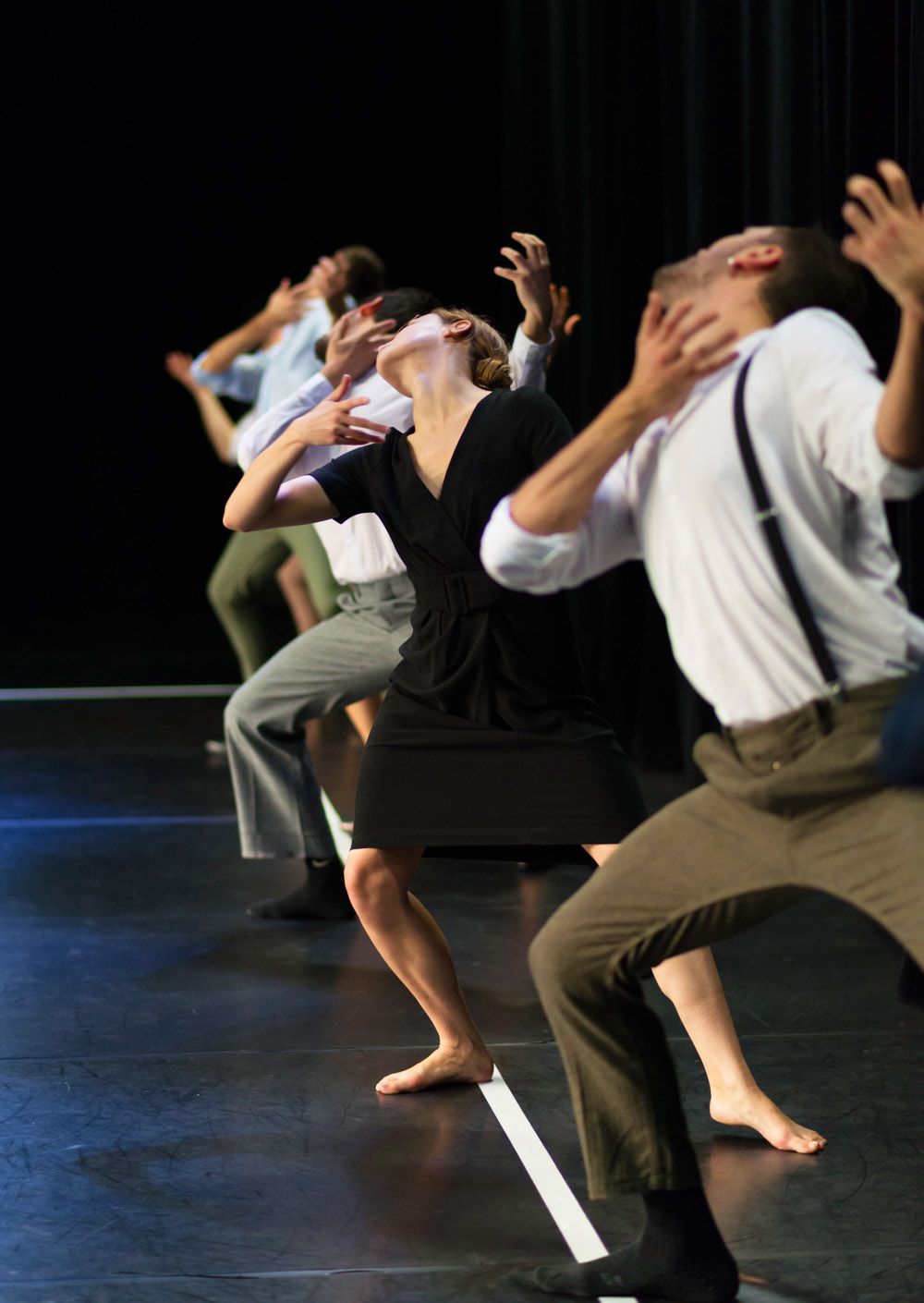
thomas lebrun
Avant toutes disparitions
“Before any disappearance“, it is urgent to live, to dance, especially to transmit. By continuing his playful exploration of the history of dance and in particular by defeating the codes of ballroom dancing, the current director of the Center chorégraphique de Tours once again imposes an intergenerational vision of his art.
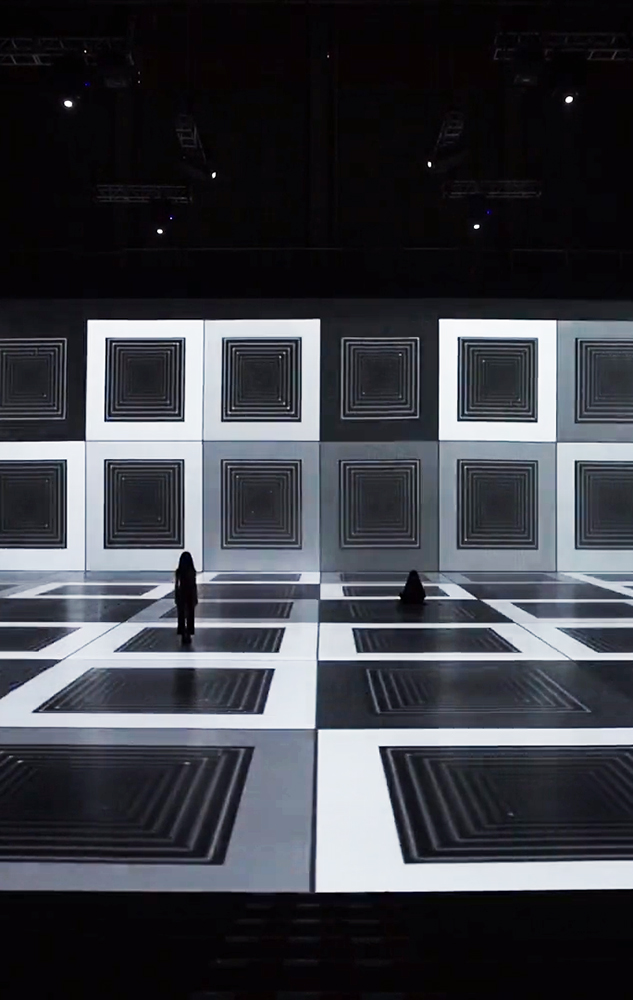
Cao Yuxi
Dimensional Sampling
Dimensional Sampling (Series) is a digital contemporary art project started by Cao Yuxi Studio in 2019. The core concept of the project is based on the digital totem of the era totem represented by the QR code image style, and further re-examine the digital age of the new era. This AudioVisual version installation is collaborative project that created with Hong Kong based sound artist Lawrence Lau.

Anne-Sarah Le Meur & Jean-Jacques Birgé
Omni-Vermille
Omni-Vermille is based on computer-generated real-time 3D images. The programmed code allows light spots to oscillate against a dark background. The colors sometimes move dynamically, sometimes calmly across the projection surface; sometimes they evoke plasticity, sometimes depth. This continuous metamorphosis endows the contents of the images with a sensual, even lively quality. The metamorphosis designed by algorithms opens up a new time-based morphology of colors and forms for painting. The play of colors is accompanied by a stereophonic sound composition by Jean-Jacques Birgé (*1952, France). The sounds follow the shapes of the colors, only to stand out again the next moment: the combination of sound and image results entirely from the laws of random simultaneity.

Michael Burk & Ann-Katrin Krenz.
Parasitic / Symbiotic
In the project “Parasitic / Symbiotic” this area of tension between nature and technology is addressed. A scenario is created in which the human being makes use of a technical device, that is sitting like a parasite on a tree. It contains a milling machine, which moves along a tree to carve encoded text into it. For the content of the carving a poem from romanticism („Abschied.“ von Joseph von Eichendorff) is used, which expresses the natural thoughts of unity and oneness and depicts the relation of nature and culture.

Mansai Nomura
MANSAI: Kaitai-Shinsho No.30 Special Edition “5W1H”
5W refers to the five interrogatives; “When, Where, Who, What and Why”, while 1H refers to the interrogative “How”. In this work, Manabe attempts to encode humans’ attitudes to these six enquiry words in an effort to explore the primitive roots of interpersonal expression, and illuminate the fundamental sources of human behavior. By converting such factors into numerical information, while drawing also on analog thinking, the piece is a search for further understanding human nature.
.
Planned by Mansai Nomura
Visual Design/Technical Direction:Daito Manabe+Motoi Ishibashi+Rhizomatiks Research
Music: Daito Manabe + Hopebox
Cast: Mansai Nomura, Yuichi Otsuki, Mansaku no kai
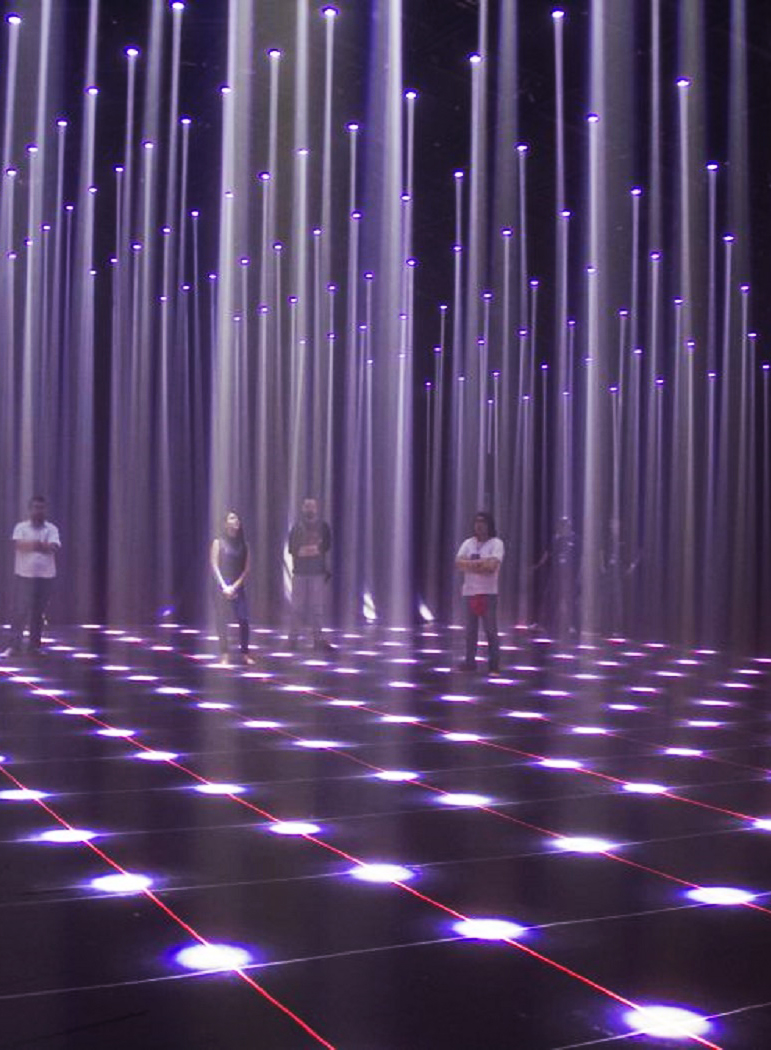
Cocolab
White Canvas
“CoCoLab engages in the area of programming languages. We provide frameworks for the analysis and the transformation of programs. Our technology is based on know-how from compiler construction. The frameworks contain parsers and preprocessors which convert source code to abstract syntax trees and symbol tables. These data structures are the foundation of program analysis and program transformation.”

FIELD
System Aesthetics
The works in this series are part of an extensive research project by FIELD, exploring the most relevant machine learning algorithms in code-based illustrations […] We have started a deeper exploration of the less accessible information that is out there, such as scientific papers and open source code publications, to develop an understanding of these algorithms’ inner workings, and translate it into visual metaphors that can contribute to a public debate.

jon mccormack
Fifty Sisters, Series of fifty evolved digital plant images
Fifty Sisters is comprised of fifty 1m x 1m images of computer synthesised plant-forms, algorithmically “grown” from computer code using artificial evolution and generative grammars. Each plant-like form is derived from the primitive graphic elements of oil company logos.

ADAM FERRISS
“Adam Ferriss is one of those technologically-minded creatives who is able to put his ever-growing knowledge of code and processing to use building aesthetically wondrous digital art for the rest of us to enjoy. His images make me feel like I’ve just taken some psychedelics and stepped into one of those crazy houses you get in funfairs, where there are giant optical illusions on every wall and the floor keeps moving under your feet, except these are made using algorithms and coding frameworks […]”

CHANG YEN TZU
Self Luminous 2 – Unbalance
Self-luminous 2 is an experimental handmade instrument shown as performance. It is a series-project which I have been working on since 2013 and finally developed into shape in 2014. I am looking for intimate and personal instrument that reflects on the relation of digital sound and light message. In computer language, light on is 1 and light off is 0. If more than 2 lamps, it could be code or readable possibility by the meanings. When I press the button or turn the knob, the message will be sent to Pure Data, and the sound will be triggered in live by Pure Data.
The Data of sound such as frequency and volume, are analysed and sent out to the second Arduino to control the light. The light, in thus case, is an intuitive element for human beings. From this point, it is really close to sound which disturbs our biological body directly. The lights are visualised and they can be transferred the into messages. The message might be readable by coincidence with the link to the code. The light is bright enough to let audience to have persistence of vision in mind. During the performance, the sound will be reproduced by code and part of it is impromptu.
.

Pedro Veneroso
file festival 2019
‘Tempo: cor’(Time:color) consists of an immersive installation that seeks to modify our experience of time by converting hours into color. A set of chromatic clocks, each set to a different GMT time zone, projects, in a semicircle, the current time in their mathematical and chromatic representations. The conversion between these two forms of time representation is based on an algorithm composed of sinusoidal functions that modulates the RGB colors as a function of the current time, gradually modifying the intensities of blue, green and red throughout the day: at midday yellow predominates, while at four in the afternoon the hour is red; midnight is blue, six o’clock in the morning is green. Side by side, the colors projected by the clocks merge, creating an immersive experience of a continuous and circular time, between the different time zones, that crosses the entire chromatic spectrum. This installation is part of a series of works in which I investigate the relationships between human notations and codes and our experience of space-time, seeking to change the ways we understand it; in this case, visitors immerse themselves in a spatial experience of time that provokes the questioning of notations and perceptions that we usually consider axiomatic. Changing the way we represent time will change our way of experiencing it?
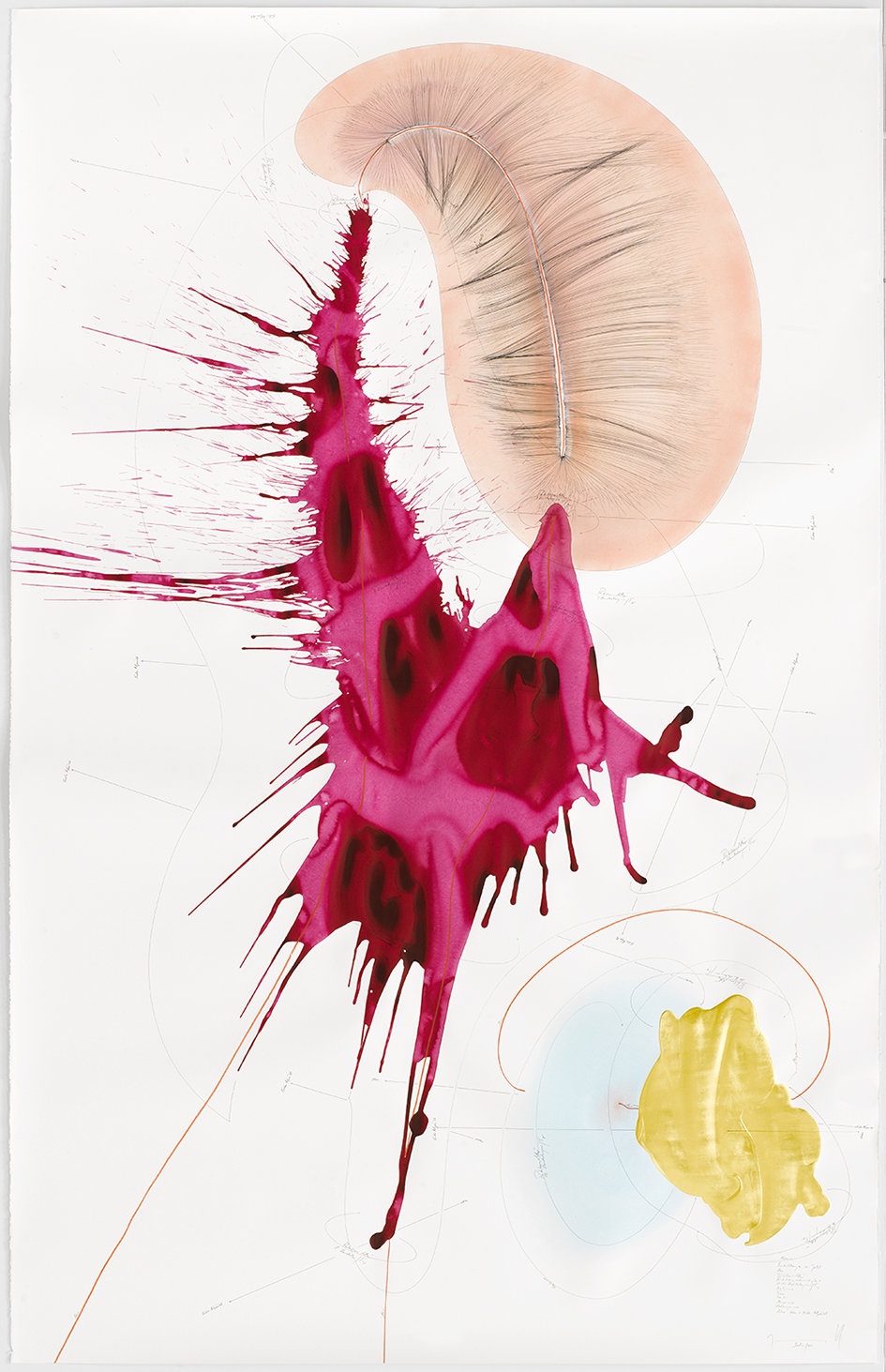
Jorinder Voigt
Jorinde Voigt is a contemporary German artist. Known for her coded drawing installations which resemble algorithms or sound waves, Voigt’s background in music and philosophical studies established her ongoing interest in probing scientific mapping processes. Throughout an inventive and playful drawing practice, her work visualizes thoughts and infinite spaces while examining the way in which information is represented visually.

RYOJI IKEDA
池田亮司
이케다 료지
Редзи Икеда
Transfinite
test pattern [n˚2] presents flickering black and white imagery that floats and convulses in darkness on two screens, one on the floor and another floor to ceiling, in time with a stark and powerful, highly synchronised soundtrack. Through a real–time computer programme, Ikeda’s audio signal patterns are converted into tightly synchronised barcode patterns on the screens. Viewers are literally immersed in the work, and the velocity of the moving images is ultra–fast, some hundreds of frames per second, providing a totally immersive and powerful experience. The work provides a performance test for the audio and visual devices, as well as a response test for the audience’s perceptions.

GUY BEN-ARY, PHILIP GAMBLEN AND STEVE POTTER
Silent Barrage
Silent Barrage has a “biological brain” that telematically connects with its “body” in a way that is familiar to humans: the brain processes sense data that it receives, and then brain and body formulate expressions through movement and mark making. But this familiarity is hidden within a sophisticated conceptual and scientific framework that is gradually decoded by the viewer. The brain consists of a neural network of embryonic rat neurons, growing in a Petri dish in a lab in Atlanta, Georgia, which exhibits the uncontrolled activity of nerve tissue that is typical of cultured nerve cells. This neural network is connected to neural interfacing electrodes that write to and read from the neurons. The thirty-six robotic pole-shaped objects of the body, meanwhile, live in whatever exhibition space is their temporary home. They have sensors that detect the presence of viewers who come in. It is from this environment that data is transmitted over the Internet, to be read by the electrodes and thus to stimulate, train or calm parts of the brain, depending on which area of the neuronal net has been addressed.
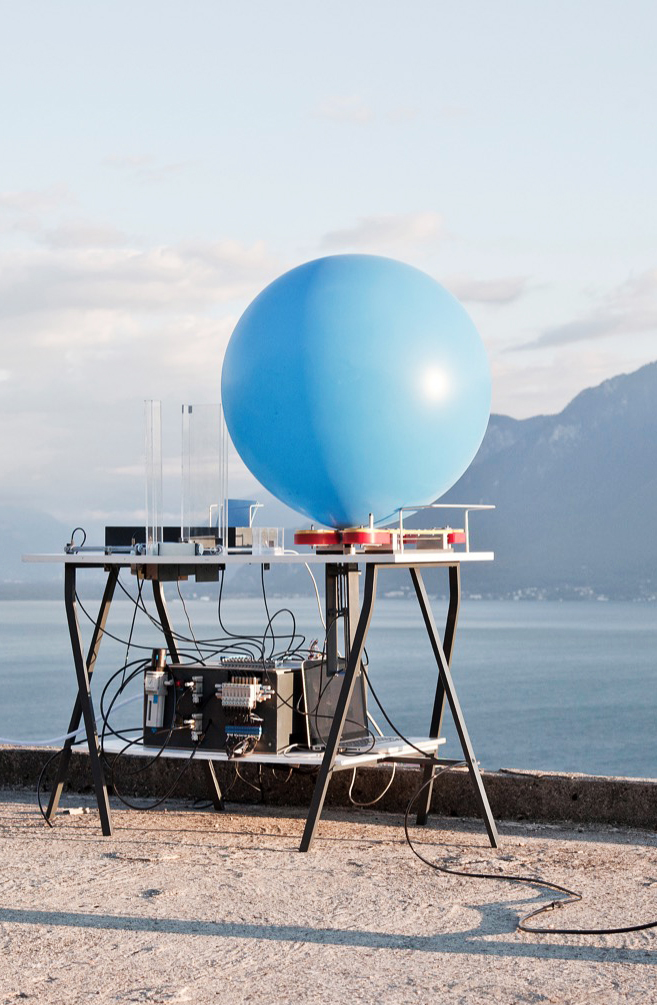
David Colombini
Attachment
This poetic machine prints your message and a code on a sheet A6, slips it into a biopolymer cylinder attached to a balloon, which is finally released into the air. Then, the balloon will travel haphazardly to a potential recipient.
Where did the idea come from? The basic idea was to take a stand against the current use of «smart» technologies by creating a poetic concept, using current technology that allows us to communicate differently and rediscover expectation, the random, and the unexpected.
For the record, I have always been attracted by what is in the air and remember having won a balloon release contest when I was about ten years old. My balloon flew from Switzerland to Austria, this definitely left an impression on me and perhaps influenced the idea of this project.

Leo Villareal
Star Ceiling
Expressing the vibrant dynamism of nature—from billowing cosmic clouds and swarming masses to radial bursts, spiraling vortices, and turbulent waves—Star Ceiling explores the tension between the rational and the transcendent, between the human and the non-human worlds. Villareal’s artwork gives life to inanimate matter through the invisible medium of code and induces a deep connectedness and rare experiential awareness.

